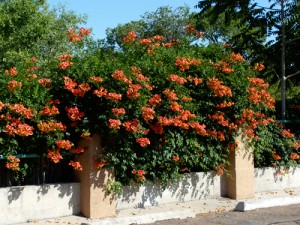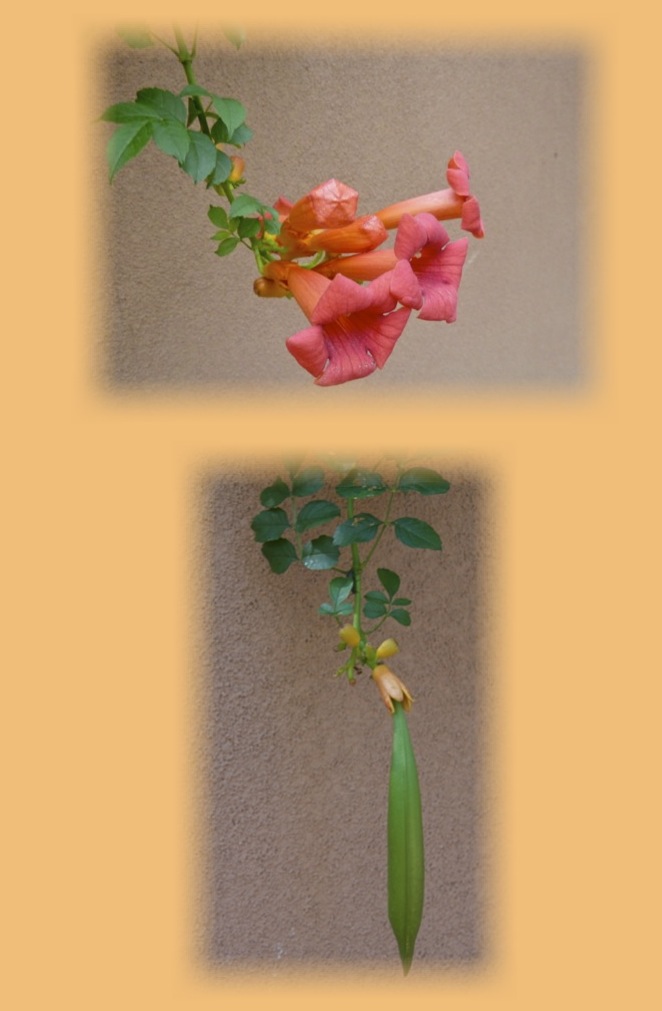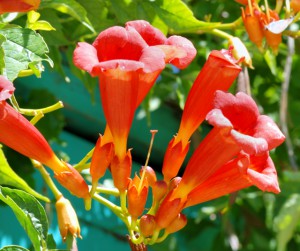Campsis radicans (American trumpet vine) and Campsis x tagliabuana ‘Madame Galen’ (Trumpet vine ‘Madame Galen’)
Plant Family: Bignoniaceae (Trumpet creeper)
Article by Janice Tucker

Campsis Mme Galen (Tracy-Neal)
Vines create interesting, vertical dimensions to one’s garden. Flowering vines add the beauty of color. Trumpet vines (Campsis spp.) contribute more than color and dimension. One can almost hear the uplifting sound of trumpets emanating from the flamboyant, orange, tubular-shaped flowers that grace a wall or arbor.
Native to the southeastern United States, the American trumpet vine (Campsis radicans) has spread to other parts of the United States and the world through the development of cultivars. Campsis x tagliabuana ‘Mme Galen’ is a cultivar developed in 1889 by the horticulturalists with the Tagliabue Nursery of Laniate, near Milan, Italy. It is a cross between the Campsis radicans (American trumpet vine) and the Campsis grandiflora (Chinese trumpet vine). The Mme Galen is the eye-catching Trumpet vine that Santa Feans usually plant in their gardens. The dividing wall between the Sanbusco Center’s parking lot and Guadalupe Center is one of the best public places in Santa Fe to view the Trumpet vine during the summer at its most colorful.
The Campsis radicans is a deciduous woody vine that leafs out on new growth later in the spring than most plants. The Madame Galen cultivar does well in hot, dry climates but does like regular moisture and full sun for optimal flowering. Without sufficient sunlight, the plant will not bloom as well. The dark green leaves are odd-pinnately compound and opposite. The Madame Galen’s orange flowers range in hues of salmon to a deep red-orange. Its vine sends out aerial roots, allowing the plant to cling to and spread along walls and fences, and up trellises and arbors. Because of the vine’s mature weight, supporting structures should be strong and sturdy. If desired, the Trumpet vine can also be grown as a ground cover, but be sure to give it plenty of space since it can spread rapidly.

Top: Trumpet vine flowers & leaves. Bottom: Pod (Janice Tucker).
The Trumpet vine spreads both by seeds and underground roots. The Madam Galen does spread quickly when planted in an ideal location but it is not as aggressive as one of its parent plants, the Campsis radicans. The Santa Fe soils, which are not known for rich nutrients, help to keep its spread in check. Pruning is best if done in February or March. Long, bean-shaped pods follow the flowers. The pods will split to release many 2-winged seeds that are dispersed by the wind. Hummingbirds, butterflies and Sphinx Moths frequent this plant throughout the summer. Although it is generally pest free, the roots of a newly planted Trumpet vine could tempt gophers.
The American trumpet vine made its way to England in the 1600’s. John Parkinson, one of England’s eminent botanists during that time, mentioned the showy climber from the American Colonies in one of his many botanical writings. However, the American trumpet vine did not become popular in England until the mid 1700’s. In 1733, John Bartram, an early American botanist and horticulturist began sending seeds or plants from the American Colonies to Peter Collinson, an avid and influential gardener in England. The American trumpet vine, known as the Bignonia radicans at that time, was among the specimens or seeds that Bartram sent. Collinson planted the Trumpet vine so that it would grow up one side of his greenhouse, ensuring the bright orange, trumpet-shaped flowers would be presented at their head-turning best. Collinson’s garden was both well-known and frequently visited by influential plant-loving Britons. Collinson often gave plants and seeds to his friends or sold them to others. In addition to his own plant orders to Bartram, he would also include those of others. The arrival of the “Bartram Boxes” was cause for more than a little excitement from those who had waited months to receive coveted seeds and plants from the American Colonies. Learn more about the impact of American plants on England’s gardens by attending Santa Fe Botanical Garden’s February 7th lecture.
The Trumpet vine will usually bloom a little later in the summer than other plants but once it begins to leaf out and then flower, it adds height and color to the garden. It can create a blanket of blooms as it wraps around a portal post or clings to a garden wall. The multitude of brilliant orange flowers adds one more dimension to the symphony in the garden landscape.

Trumpet vine flowers (Janice Tucker)


